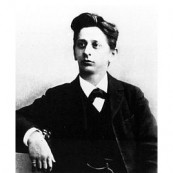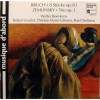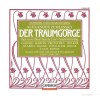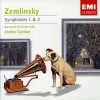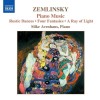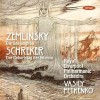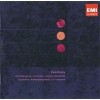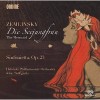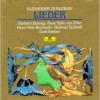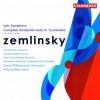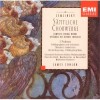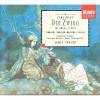传记
Alexander Zemlinsky or Alexander von Zemlinsky (October 14, 1871, Vienna – March 15, 1942, Larchmont, New York) was an Austrian composer, conductor, and teacher.
Zemlinsky was born in Vienna to a highly multicultural family. Zemlinsky's grandfather, Anton Semlinski, emigrated from Žilina, Hungary (now in Slovakia) to Austria and married an Austrian woman.[1] Both were from staunchly Roman Catholic families, and Alexander's father, Adolf, was raised as a Catholic. Alexander's mother was born in Sarajevo to a Sephardic Jewish father and a Bosnian Muslim mother. Alexander's entire family converted to the religion of his grandfather, Judaism, and Zemlinsky was born and raised Jewish. His father added an aristocratic "von" to his name, though neither he nor his forebears were ennobled. He also began spelling his surname with a "Z."[2]
Alexander studied the piano from a young age. He played the organ in his synagogue on holidays, and was admitted to the Vienna Conservatory in 1884. He studied piano with Anton Door, winning the school's piano prize in 1890. He continued his studies until 1892, studying theory with Robert Fuchs and composition with Johann Nepomuk Fuchs and Anton Bruckner.[3] At this time he began writing music.
Zemlinsky had a valuable supporter in Johannes Brahms. In 1893, On the invitation of Zemlinsky's teacher Johann Nepomuk Fuchs, Brahms attended a performance of Zemlinsky's Symphony in D minor. Soon after that, Brahms attended a performance of one of Zemlinky's quartets by the Hellmesberger Quartet. Brahms, impressed with Zemlinsky's music, recommended the younger composer's Clarinet Trio (1896) to the N. Simrock company for publication.[4]
Zemlinsky also met Arnold Schoenberg when the latter joined Polyhymnia, an orchestra in which he played cello and helped found in 1895. The two became close friends and later mutual admirers and brothers-in-law when Schoenberg married his sister Mathilde. Zemlinsky gave Schoenberg lessons in counterpoint, thus becoming the only formal music teacher Schoenberg would have.
In 1897 Zemlinsky's Symphony No. 2 (chronologically the third he had written, and sometimes numbered as such) was a success when premiered in Vienna. His reputation as a composer was further helped when Gustav Mahler conducted the premiere of his opera Es war einmal... (Once Upon a Time) at the Hofoper in 1900. In 1899 Zemlinsky secured the post of Kapellmeister at Vienna's Carltheater.
In 1900, Zemlinsky met and fell in love with Alma Schindler, one of his composition students. She reciprocated his feelings initially; however, Alma felt a great deal of pressure from close friends and family to end the relationship. They were primarily concerned with Zemlinsky's lack of an international reputation and by an unappealing physical appearance. She broke off the relationship with Zemlinsky and subsequently married composer Gustav Mahler in 1902. Zemlinsky married Ida Guttmann in 1907, but the marriage was an unhappy one. Following Ida's death in 1929, Zemlinsky married Luise Sachsel in 1930, a woman twenty-nine years his junior, and to whom he had given singing lessons since 1914. This was a much happier relationship, lasting until Zemlinsky's death.
In 1906 Zemlinsky was appointed first Kapellmeister of the new Vienna Volksoper, from 1907/1908 at the Hofoper in Vienna. From 1911 to 1927, he was conductor at Deutsches Landestheater in Prague, premiering Schoenberg's Erwartung in 1924. Zemlinsky then moved to Berlin, where he taught and worked under Otto Klemperer as a conductor at the Kroll Opera. With the rise of the Nazi Party, he fled to Vienna in 1933, where he held no official post, instead concentrating on composing and making the occasional appearance as guest conductor. In 1938 he moved to the United States and settled in New York City. Although fellow émigré Schoenberg was celebrated and feted in the Los Angeles of the 1930s and 40s – teaching at the University of California, Los Angeles (UCLA) and the University of Southern California (USC) and gaining a new generation of acolytes – Zemlinsky was neglected and virtually unknown in his adopted country. He fell ill, suffering a series of strokes, and ceased composing. Zemlinsky died in Larchmont, New York of pneumonia.
Zemlinsky's best-known work is the Lyric Symphony (1923), a seven-movement piece for soprano, baritone and orchestra, set to poems by the Bengali poet Rabindranath Tagore (in German translation), which Zemlinsky compared in a letter to his publisher to Mahler's Das Lied von der Erde (though the first part of Schoenberg's Gurre-Lieder is also a clear influence). The work in turn influenced Alban Berg's Lyric Suite, which quotes from it and is dedicated to Zemlinsky.
Other orchestral works include the large-scale symphonic poem Die Seejungfrau (The Mermaid). This work, premiered in 1905 in the same concert as Schoenberg's Pelleas und Melisande, was considered 'lost' until 1984, since when it has become one of Zemlinsky's most frequently performed scores. A three-movement Sinfonietta written in 1934, admired by Schoenberg and Berg, is written in a style comparable to contemporary works by Paul Hindemith and Kurt Weill.
Other works include eight operas (including Eine florentinische Tragödie (1915–16) and the semi-autobiographical Der Zwerg (The Dwarf, 1919–21), both after Oscar Wilde); chamber music (including four string quartets) and the ballet Der Triumph der Zeit (1901). He also composed three psalm settings for chorus and orchestra and numerous song cycles, both with piano and with orchestra, of which the Sechs Gesänge, Op. 13, to texts by Maurice Maeterlinck is the best-known.
While the influence of Brahms is evoked in Zemlinsky's early works (prompting encouragement from Brahms himself), an original voice is present from the first works on, handling dissonances in a much freer manner than Brahms. Later works adopt the kind of extended harmonies that Wagner had introduced whilst also drawing influence from Mahler. In contrast to his friend Schoenberg, he never wrote atonal music, and never used the twelve-tone technique. However, late works such as the Symphonische Gesänge, Sinfonietta and third and fourth string quartets move away from post-Romanticism towards a leaner, harder-edged idiom that incorporates elements of Neue Sachlichkeit, Neoclassicism and even jazz.
As a conductor, Zemlinsky was admired by, among others, Kurt Weill and Stravinsky, not only for his notable interpretations of Mozart, but also for his advocacy of Mahler, Schoenberg and much other contemporary music. As a teacher, his pupils included Erich Wolfgang Korngold, Hans Krása and Karl Weigl.





